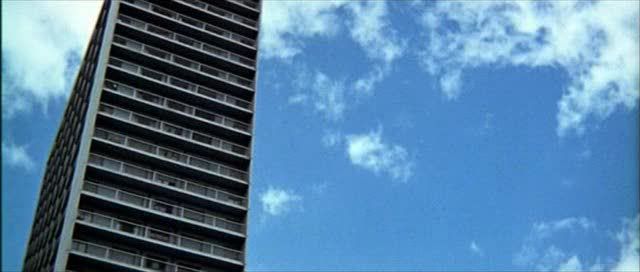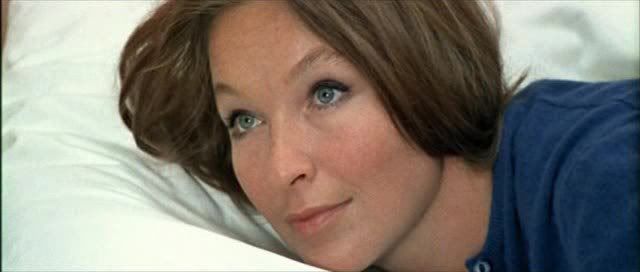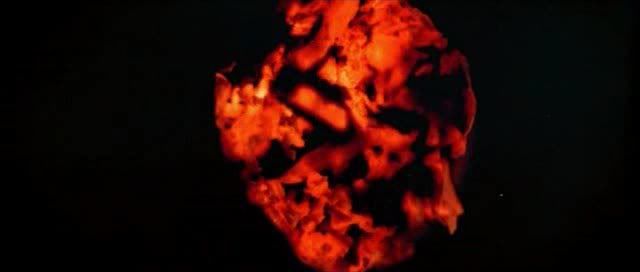
Two Or Three Things I Know About Her marks a crucial stage in the career of Jean-Luc Godard. It is perhaps the first film in which he explicitly elucidates and rigorously develops an idea that had been present, in more or less implicit form, ever since he started making feature films, and which would finally become a guiding principle of his filmmaking with his late 1960s turn to political radicalism. The idea that there exists a democracy of images, that one image is no more or less valid, interesting, and worthy of note than any other possible image, is in direct contradiction of so many of the norms of modern culture that, even today, it remains a radical statement. Godard's assertion that stories and characters can be abandoned to study the leaves on a nearby tree, or the swirling rings stirred up by a spoon in a coffee cup, is radical because it steps away from the conventions of Hollywood film and the aspirations of classical art alike; both of these venerable cultural institutions aim to create images that are potent, memorable, and intrinsically interesting. Godard, who had always recognized that boredom could be just as "interesting" as activity, here goes even further, positing still more unconventional equalities: between narrative and abstraction, between beauty and the prosaic, between reality and fiction, between people and objects, and, in a clear forerunner of his later films, between sound and image.
To this end, the people in the film are subsumed by the images, their role in the film reduced by the way that Godard positions them within the frame, often with just their heads poking up from the very bottom of the image, silly bobble-head dolls disconnected from their rarely visualized bodies. Even the closeups promulgate this reduction of the human role, with the people's faces rendered faintly ridiculous by their constriction within the tight Scope boundaries. For these shots, Godard treats his frames like a French flag (the bright primary colors of which define the film's visual palette as well), divided into three equal areas, a head in the center surrounded on either side by equal portions of dead space. The image is one-thirds face, two-thirds nothingness, and the flatness of the compositions suggests a profound equivalence between the person and the nothing. It is not only that Godard considers a person and an urban landscape equally interesting, but that he sees them as reflections of one another; he finds one in the other. Forced to choose between describing the movement of leaves or the state of his main character, he flippantly uses the same word for both: they each "tremble" on a cold day. Godard introduces his heroine first as an actress, Marina Vlady, and only secondarily as the character she plays, the bored housewife and part-time prostitute Juliette Jeanson. Even the title creates these kinds of equivalencies: immediately after the words appear, Godard inserts a second title card that identifies "her" as Paris. Only secondarily, again, does a voiceover link the word "her" to the woman at the center of the picture, either Marina Vlady or Juliette.
This is the most narratively destabilized of Godard's 1960s films, in that narrative is allowed to simply fritter away. In Weekend, Godard at least gave the narrative enough respect to acknowledge that he is destroying it: the destruction of narrative becomes, itself, the narrative of the film. Here, the narrative is simply missing, as profound an absence as the mostly unfilmed bodies of the characters. When Godard's voiceover explicitly notes that he is taking a detour from the narrative in order to film a tree instead, the only possible response is, "what narrative?" Juliette has a cipher of a husband (Roger Montsoret) who listens to voices coming over the radio and takes notes, a modernist version of Jean Cocteau's Orphée who, instead of hearing poetry, hears Lyndon Johnson apologizing in a paraphrase/thievery of a 1966 Jules Feiffer comic strip about the president's "heavy heart" and unwilling bombings. She also has a pair of unruly children, a number of nearly anonymous friends, and a succession of johns with whom she never seems to consummate any transactions. That is to say, there is a lot of activity surrounding Juliette, and a lot of related characters, but is there a narrative?

What Godard offers in place of a narrative is talk, and lots of it. Not that he trusts language in itself, and one of the film's purposes is to question the stranglehold of words over things by the repetition of basic philosophical quandaries involving the naming of objects. How do we know what blue is? How do we describe a thing when everyone sees it in a slightly different way? Godard's examples are trivial — a blue shirt and a magazine seen from various angles — but his intent is entirely earnest, a desire to question even basic assumptions and thus trigger deeper thought. This questioning is achieved by fragmenting the formal unity of the film and initiating discourse on all planes of reality. Characters talk to one another, they talk to themselves, and they break character and talk directly to the camera, often while in the midst of performing the banal routines that constitute the film's only real narrative: washing dishes, putting the children to bed, shopping. Godard also talks within the film, and quite a lot, providing a whispery voiceover that sometimes comments obliquely on the action and at other times takes off on tangents of its own.
The same is true of the characters' conversations and monologues, which range freely over a wide variety of topics, from the alienation and boredom of ordinary life in an industrial society, to new designs for dresses, to the idea of courage. The talk is fast-paced and allusive — not to mention elusive — and in one scene Godard flips back and forth between two distinct conversations going on in a café, blending them through a precise shot sequence that leads from a participant in one conversation to a participant in the other. It's as though a baton has been handed off in a relay race, and the other speakers take up their turn before passing things back to the original duo. The scene is further broken down by the interjection of a third duo, who simply read random quotes aloud from a prodigious stack of books. For Godard, the exact content of all this speech is not nearly as important as its existence, the possibility that this accumulation of language might paradoxically provide a way to break through language's barriers. This hope leads Godard to another of his radically destabilizing equivalences, the privilege he grants to quotation as being on par with "original" statements. Certainly, the film quotes freely, not only from books, cinema, commercial culture, and comics, but from Godard's own previous films. The bar where the prostitute Juliette goes to hang out, with its pinball machine and large glass windows, recalls another bar and another prostitute, from My Life To Live, while the bedroom conversation between Juliette's friend Marianne (Anny Duperey) and a loutish American war photographer (the producer Raoul Lévy) is like a politicized Breathless in miniature.

The film also looks forward to Godard's future work, not only in the increasing abstraction of the narrative, but in the way he explores the themes of family, sexuality, and work in a politically radicalized context. In that respect, the film it most resembles in Godard's oeuvre is Numéro Deux, for which Two Or Three Things seems to be both a foundational primer (even providing the later film with its central metaphor of the human form as landscape) and a sexually tamer mirror image. This film's chasteness about the body, which is literally cut off from the characters for most of the film, reflects the impossibility of an honest discourse about sexuality in a context where sex has been transformed into a commodity. The film's final image, of a grassy field in which consumer products have been arranged in complex geometric patterns, suggests the maze that consumerism has made for genuine expression, trapping nature within its rigid borders. Godard makes every effort to free himself from this maze, but his treatment of sexuality is much more rigorously developed by the time of the later Numéro Deux, perhaps influenced by the additional participation of Anne-Marie Miéville. That film has none of the lasciviousness with which Godard's camera eyes a young beauty taking a bath, in a scene that purports to literalize commercialism's intrusion upon privacy and sensuality — a meter reader cheekily walks in as the girl is drying herself — but actually documents only Godard's continuing fascination with the female form.
It's a unique but telling moment in a film where the director otherwise purposefully denies himself, and his audience, these kinds of fleshy pleasures. He has made a film about prostitution which focuses on the transaction, the commerce, but never on the unseen sex. The film's scenes of prostitution are lengthy and deliberate stripteases in which the girls are mostly not actually seen taking off their clothes; Juliette especially just stands off to the side talking, to herself or the camera, rather than actually getting intimate with her clients. She's a sexless prostitute, precisely because money drains the sex even from sex itself. The American photographer (recently from Vietnam and tired of seeing so many "atrocities") forces Juliette and Marianne to enact bizarre rituals in which they put bags over their heads and run past each other repeatedly. Godard cuts from this sequence directly to a shot of construction cranes maneuvering against a pale blue sky, and the metaphor is obvious: commerce transforms sex into just another industrial commodity, a set of mechanical maneuvers that must be completed in order to enact a process. It's a theme Godard would return to, in an even more convoluted and hilarious way, in Sauve qui peut (la vie) some years later.
If Godard's distractions, detours, and abstractions here have a powerful political point to make, it's also important to note that to some extent Godard is embarking on a strategy of detours for their own sake. There are so many detours here that it's frequently difficult to remember what, if anything, is being detoured from. It's impossible to deny the obvious pleasure that Godard takes in these abstractions, as when he cuts between a closeup of Juliette and an increasingly zoomed-in view of a cup of coffee: quick, perfunctory shots of the film's star, followed by long, lingering gazes into the depths of the coffee, finding odd spiraling patterns like galaxies and bubbling supernova fissions within the liquid's smooth black surface. Each subsequent shot pushes deeper into the cup, starting from a shot where the blue-green rim is still visible and then leaping headfirst into the abstract void where the swirling patterns within the black become an entire starfield filling the screen. A shot towards the end of the film, where Godard finds volcanic depths and star explosions in the pulsating flame of a cigarette tip, is similarly loving and intense. These moments, as much as any of the film's figurative images of either people or objects, indicate Godard's profoundly political conception of the image as a liberating tool. Just as his cinema is increasingly freed from conventions of all kinds — both progressive and reactionary — so do his abstract visuals suggest a similar freedom for the viewer: the freedom to forget about the idea of a story or a character or even of a film altogether, and to simply stare into a coffee cup for a while, letting its spirals lead your thoughts where they will.
As you undoubtedly know, 2 ou 3 choses que je sais d'elle was made simultaneously with Made in U.S.A.
ReplyDeleteIdeally they should be shown "Wild Palms" style with alternating reels.
Yes. Although I vastly prefer 2 or 3 Things, I like the idea of alternating between it and Made in USA, which in that context might seem like it was providing the missing sense of narrative that had been sucked out of the other picture.
ReplyDelete2 or 3 Things reconcieves Paris though its suburbs. This is place Tati imagined on Playtime (1963-1967), Rohmer evoked in L'Ami de Mon Ami, and Jean-Claude Guiguet examined with grave lyricism in Les Passagers.
ReplyDeleteExcellent review, but I have one reservation...
ReplyDeleteWhen this quote - "The idea that...one image is no more or less valid, interesting, and worthy of note than any other possible image" - is placed aside this snippet - "Godard's profoundly political conception of the image as a liberating tool" - I sense some contradiction. I'm wondering if you could clarify how these statements are not contradictory regarding Godard's views of the image. If no image is more powerful than any other, how is it that the micro close-ups of coffee and cigarette tips are more intrinsically compelling?
Interesting point, Carson. I should add it's been a while since I last rewatched this particular film, but my understanding of Godard's thesis of the image, as presented in this film, is that he's suggesting an equivalence between the things usually focused on in a feature film -- story and character, in other words images of people and of things happening -- and the things that make up the more prosaic texture of ordinary life. So, since feature films usually ignore such things, Godard turns his camera on intimate closeups of coffee cups or cigarette tips or leaves swirling in the breeze, or for that matter the film's many shots prominently featuring brand-name consumer products. It's not that he thinks the coffee cup is "more intrinsically compelling" than anything else, but that he considers it just as compelling and valid an image as one which would advance the narrative in a more conventional way. That's my read on it anyway.
ReplyDeleteThanks for the response; I must be honest, I didn't expect it on such a distant post. I understand your point and I think you've hit on the head perhaps the purpose of his use of images in the film. Thank you for the clarification.
ReplyDelete